When you’re doing any type of renovation, it’s important to determine what you can and cannot do, and what you’re willing to spend extra time learning to do yourself. When you consider the labor rates that contractors charge, you need to factor in their experience and the quality of their work. But it’s also advisable to consider what your own time is worth and whether or not that time is better spent doing something else that will earn you the money to pay for your renovation.
In my case, because I work with my hands and also do project management for a living, I’m willing to do more research and get my hands dirty. On the other hand, there’s such a big learning curve for me in working with my vintage Airstream, that I knew ahead of time there were certain things that were better left to a professional. For example, anything I consider “automotive” (like the chassis, axles, towing, brakes, &c.), any interior or exterior skin work, and the electrical, plumbing and HVAC systems are things I’m happy to delegate at the right price. After I bought my first Airstream in 2011 and started doing research, one name kept coming up as a premier vintage Airstream restorer – Colin Hyde.
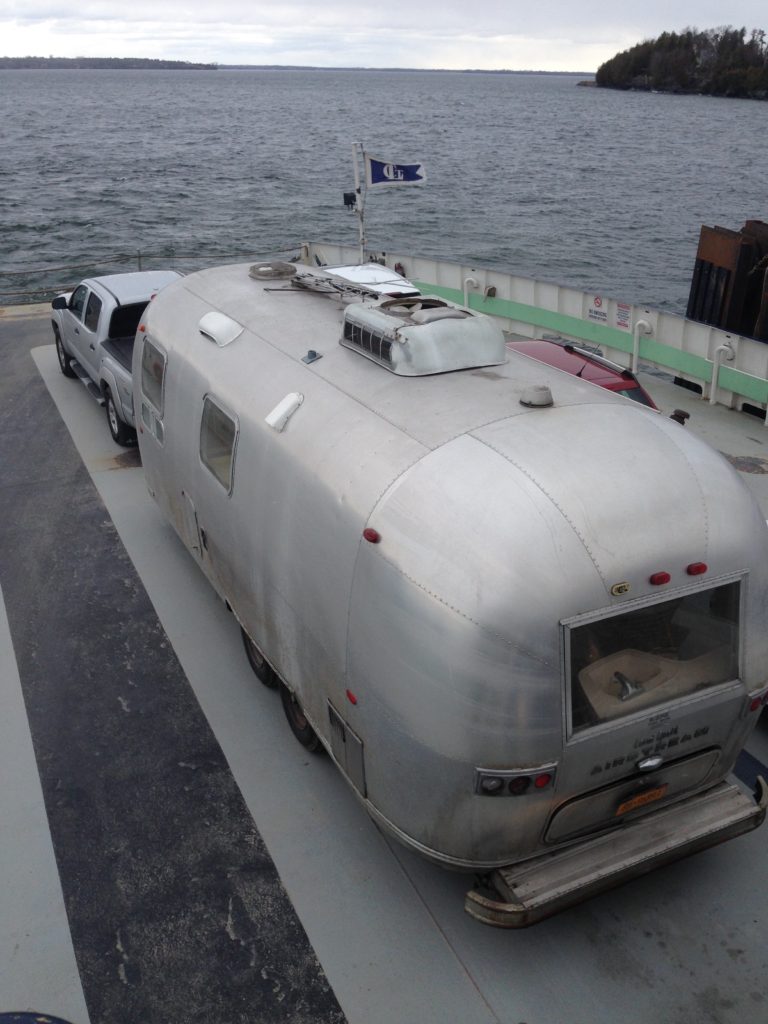
The circumstances and scope related to my project have changed a great deal over the past few years. Since 2012, I’ve spoken at length with Colin over the phone three times, and each time he’s been very generous with his time, clarifying my options and helping me to understand Airstreams better. I usually prepared for our calls by listening to old episodes of the Vintage Airstream Podcast (where he’s a featured panel pro). I also took a lot of notes during each phone call that have been very helpful after the fact in working with my budget, prioritizing tasks and ordering parts. The challenge is that it’s hard for any contractor to assess the scope of work or give you an accurate time frame or pricing without seeing what needs to be done in person.
Even then, issues can arise that may not become apparent until you start work, open a wall, test a system, &c. This is where construction projects often fall victim to the dreaded “scope creep” and change orders that can drastically affect the budget. The best you can do is get ballpark or “allowance” pricing for parts and labor, then wait to see what actually happens. Of course, the more experienced your contractor (and their team), the better the chance they’re able to anticipate common problems, resolve issues quickly and give you a more accurate sense of price & timing.
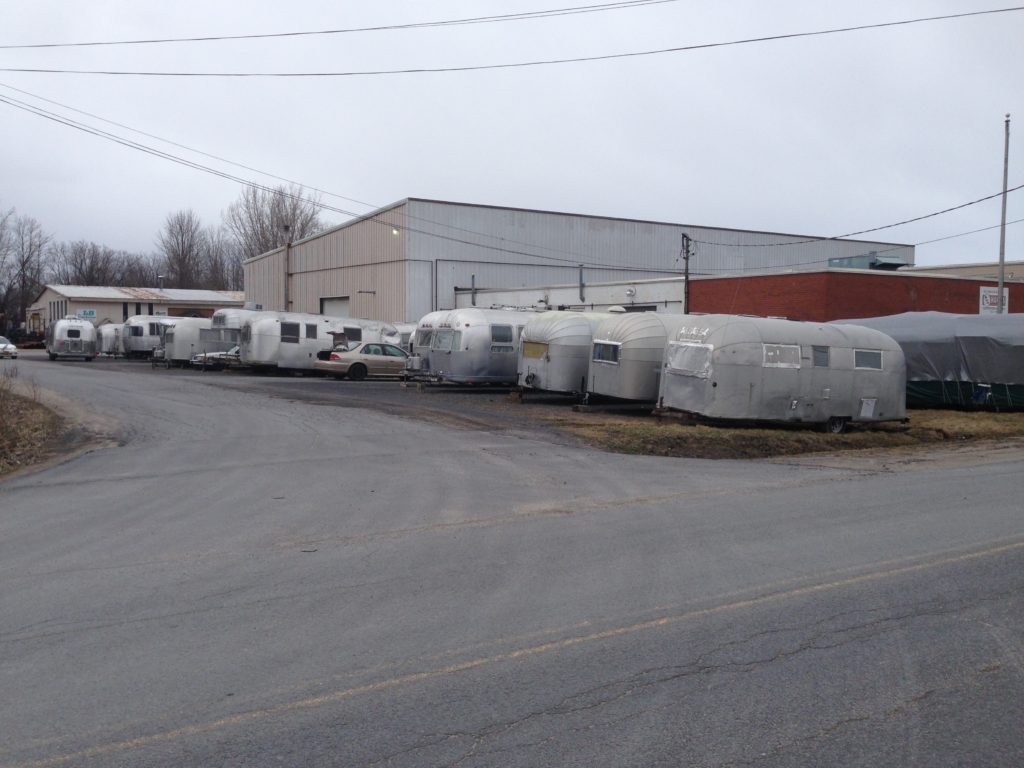
I was now on the way to my appointment with Colin to replace my axles and shocks, and go over the remaining scope of work. He’s a good 6 or 7 hours north of where I live, and a couple of hours from the welder I had just been working with in Vermont. I felt very excited to finally meet Colin and see the shop… it meant I was finally going to get the bulk of work done on my trailer and really get a clear picture of how well the systems in it were working.
This was the first week of April and I’d last spoken to Colin at the beginning of February. When I’d last had him on the phone, we’d reviewed the scope of work I wanted to accomplish to get ready for my trip, I got a general sense of pricing and a preliminary list of the parts I’d need to buy, and we placed an order for two new axles to arrive in about a month. My understanding was that we’d start with the axle replacement, and he’d take a day or two to analyze the systems.
From that assessment, he would let me know exactly what I needed and then I could buy all of the parts at once from the relatively local Vintage Trailer Supply shop in Montpelier, VT for immediate delivery to Colin. I’d already confirmed that VTS has almost all of their products in stock, and that I could get a discount for purchasing at a significant volume. So that was motivation for me to assemble a complete list of needed parts and then place the order. If need be, I could stay local for a day or two and buy what Colin needed, then head home while the repair work was being done.
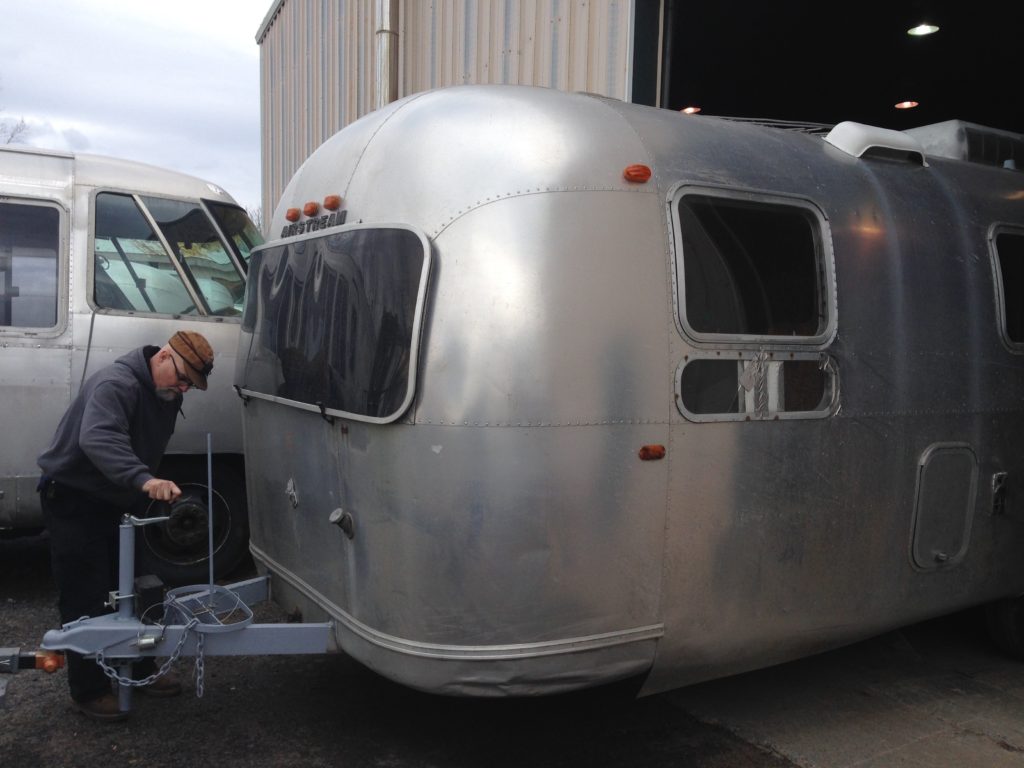
In addition to the axle & shock replacement, we’d discussed having him:
- Install / adjust my Hensley sway control hitch
- Set up propane system including refrigerator & stove / oven diagnosis / repair
- General assessment of electrical system (including all interior / exterior lights & outlets)
- Install new battery, amp converter & 12-volt fuse box
- General assessment of plumbing system
- Air conditioner & vent diagnosis / repair / replacement
- Install a new Deadbolt lock on the entry door
- Front street-side broken window: Reinstall w/ new glass
- Front curb-side window: Install window striker plate
- Curb side window (over gaucho): Install lever arm
- Tighten window lever arms throughout
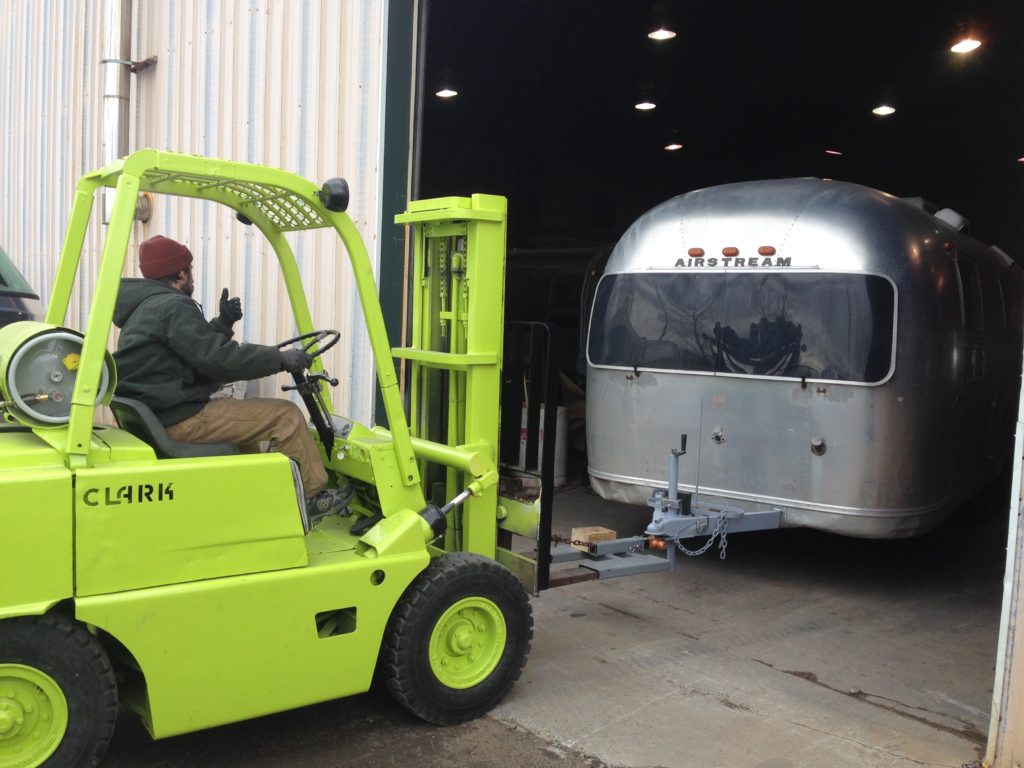
When I finally arrived at the shop after my unexpectedly prolonged visit to the welder, it was early in the afternoon on a Friday. The timing was good because I knew I had a few hours to go over the scope with Colin in depth and it would give him a chance to get a good first look at the trailer.
In person, Colin is every bit the affable, knowledgeable guy I’d come to expect from listening to hours of The VAP podcasts and from talking to him over the phone a couple of times. We reviewed the aspects of the scope I wanted his team to complete, and we went into a good deal of detail. As we talked, I took my notes and added to the list of parts & products I needed to buy. After a couple of hours, we left it that I would e-mail him a copy of the scope on Monday, he’d take a closer look at the trailer, and then by phone, we’d finalize the list of things I needed to have delivered to him from Vintage Trailer Supply so that the renovation could progress in a timely fashion. It was important to me to hand off any loose parts needed for the installation to him directly, to make sure that everything was clear and accounted for. He agreed, and I left them in his care. In the meantime, two of his crew had quickly removed my old axles and had already started positioning the new ones under the trailer for installation.
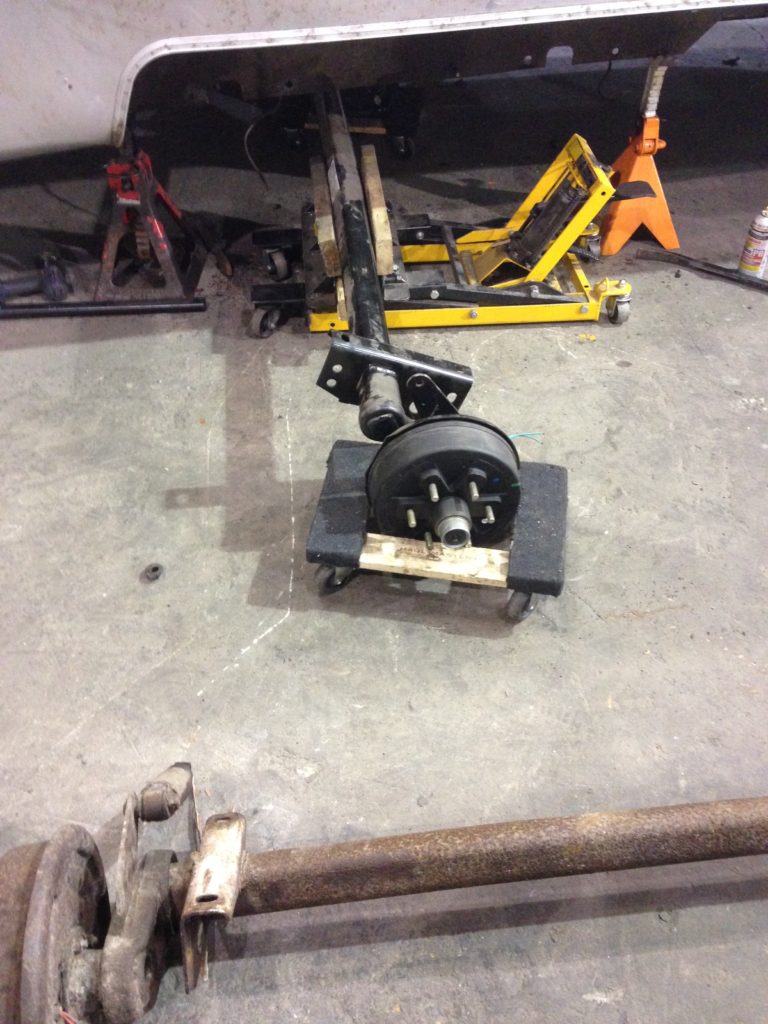
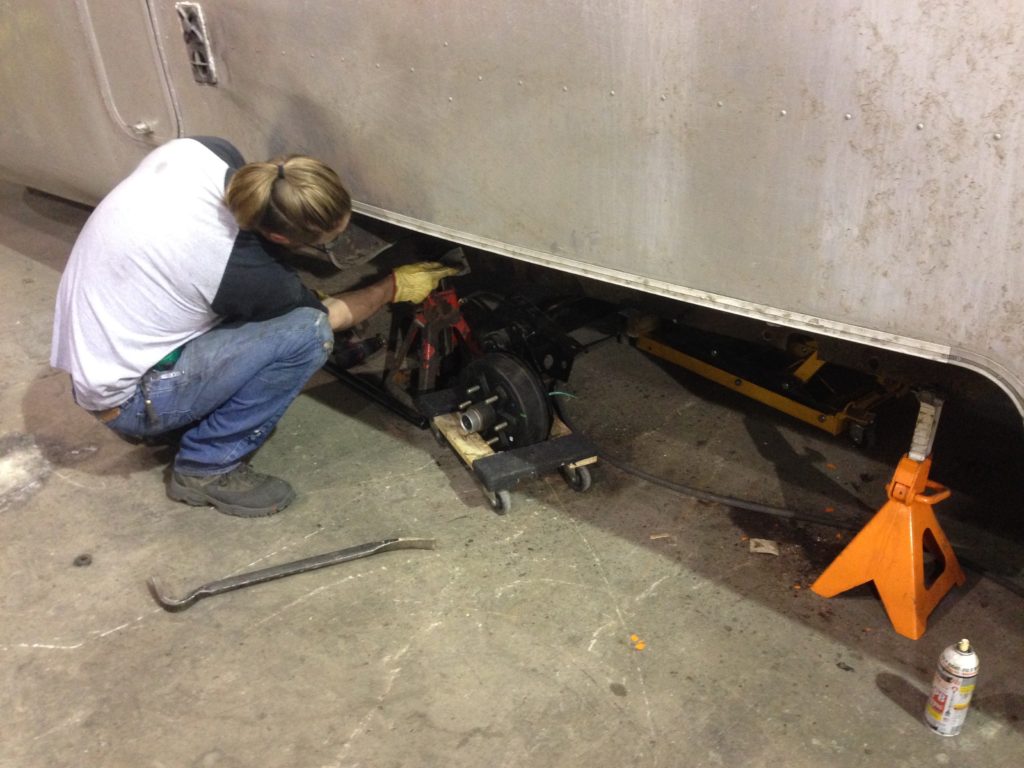
With Colin’s kind permission, I hung around the shop for about another half hour, looking at the many works-in-progress and taking pictures of of the amazing trailers – Airstream and otherwise – that filled both the workshop and his ample parking lot. His crew was great as well, taking time to talk with me about the different projects and tools, and giving me encouragement that a lot of the work in restoring a vintage Airstream is manageable for a handy do-it-yourselfer. I left a little before the end of their work day and started on the long trek back home. I was happy and relieved that the next time I saw the trailer, the majority of my renovation would be complete.
As promised, I sent a copy of the scope to Colin the following Monday afternoon. A couple of hours later, I was shocked to get this reply:
“Hi James,“Your axles have been installed along with new shocks & the trailer has been moved outside. We don’t have time to do the other work requested at the moment or have space to store your trailer until your parts arrive. I would suggest that you pick up the trailer & take it to your welder to complete that work, then let me know when you have all of the parts accumulated so we can see if the work will fit into our schedule. I will complete your invoice to date tomorrow.Thanks,Colin”
Because this hadn’t been our understanding, I responded by expressing a wish that this would have been discussed with me in advance so that I could have either postponed the axle order until everything could be done at once, or at least that this could have been conveyed to me on Friday so that I could have stayed local and driven the trailer home Monday instead of going all the way home and immediately having to make a second trip back.
Feeling discouraged and pretty heated, I made the return trip a couple of days later. On the long ride up, I decided to focus on any questions I’d have about the renovation so that I could get the most value from this journey. When I got there and we sat down to settle the bill, I expressed my concerns and negotiated with him to take a couple of labor hours off of his price. It didn’t really cover the cost of my time or travel expenses for the extra trip, but it did represent an amiable compromise for the inconvenience. I gathered some more information, and we left it that I would purchase the items needed for the renovation and then return with them in hand for the work to be done in May. I was given by him that it was ok to follow up with him by phone and e-mail, being as persistent as needed (with consideration for the volume of correspondence he gets every day) until we could figure out a date in the near future for me to return.
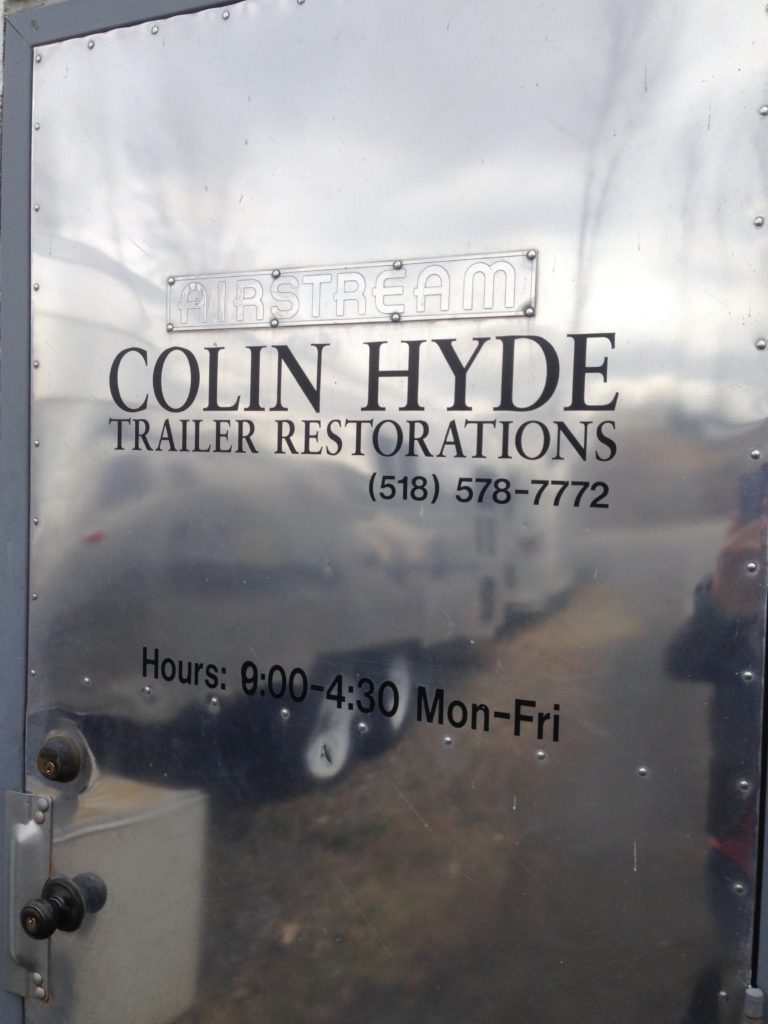
In a perfect world (and in my experience doing residential construction), this is how you want to manage a renovation:
The contractor or subcontractor thoroughly reviews the scope of work on site, gives an estimate and determines the schedule with you, and then signs a contract holding them to the terms. A preliminary payment may be made at this time. In the meantime, materials are ordered and delivered to the site so that when work begins, everything is there so that work can progress without delay. However in cases like this, there may be no contract, and the specialized nature of the work can mean that the contractor is in high demand (especially during certain seasons), juggling many projects at once. Smaller outfits sometimes have a limited staff and other resources that require persistent and thorough communication on your part to ensure that everything goes smoothly.
Anyway, I eventually arrived back home and counted my blessings. I had just gotten a lot of essential work done in about a weeks’ time. I had a newly reinforced chassis, and new axles that would ensure much, much safer travels down the road. I’d been able to review my project with a pro and get information that helped me identify most of the remaining materials I’ll need for the next stage of the work. Having the trailer back home for a couple of more weeks meant that I could remove a window that needed replacement by myself and at least save myself that much in labor. It means that I can potentially remove the rest of the belly pan that I’d started taking off earlier this month, which would allow for more of the chassis to be repaired next time I go to the welder and for potential rodent access points to be closed. I could also take the time to do little DIY tasks that will help me get road-ready to keep the project moving. And if I can indeed return to work with Colin in May, I’ll still be on track with my construction schedule. In the meantime, I’ll persist with my communications and see about setting up an appointment to return…
Visit the Little Green Airstream’s Facebook page for additional photos of my visit to Colin Hyde Trailer Restorations





This has been an amazing journey thus far. I know you look forward to
completion in the near future. May the gods overseeing Airstream
Renovation favor your project with a high priority status!
Thank you!